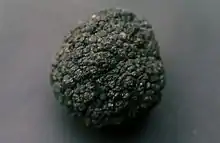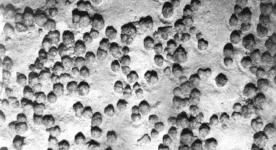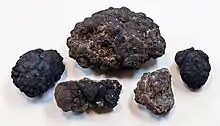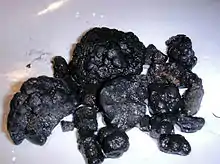


Polymetallic nodules, also called manganese nodules, are mineral concretions on the sea bottom formed of concentric layers of iron and manganese hydroxides around a core. As nodules can be found in vast quantities, and contain valuable metals, deposits have been identified as a potential economic interest.[1] Depending on their composition and autorial choice, they may also be called ferromanganese or polymetallic nodules. Ferromanganese nodules are mineral concretions composed of silicates and insoluble iron and manganese oxides that form on the ocean seafloor and terrestrial soils. The formation mechanism involves a series of redox oscillations driven by both abiotic and biotic processes.[2] As a byproduct of pedogenesis, the specific composition of a ferromanganese nodule depends on the composition of the surrounding soil.[2] The formation mechanisms and composition of the nodules allow for couplings with biogeochemical cycles beyond iron and manganese.[2] The high relative abundance of nickel, copper, manganese, and other rare metals in nodules has increased interest in their use as a mining resource.[3][4]
Nodules vary in size from tiny particles visible only under a microscope to large pellets more than 20 centimetres (8 in) across. However, most nodules are between 3 and 10 cm (1 and 4 in) in diameter, about the size of hen's eggs or potatoes. Their surface textures vary from smooth to rough. They frequently have botryoidal (mammillated or knobby) texture and vary from spherical in shape to typically oblate, sometimes prolate, or are otherwise irregular. The bottom surface, buried in sediment, is generally rougher than the top due to a different type of growth.[5]
Occurrence
Nodules lie on the seabed sediment, often partly or completely buried. They vary greatly in abundance, in some cases touching one another and covering more than 70% of the sea floor surface. The total amount of polymetallic nodules on the sea floor was estimated at 500 billion tons by Alan A. Archer of the London Geological Museum in 1981.
Polymetallic nodules are found in both shallow (e.g. the Baltic Sea[6]) and deeper waters (e.g. the central Pacific), even in lakes,[7] and are thought to have been a feature of the seas and oceans at least since the deep oceans were oxygenated in the Ediacaran period over 540 million years ago.[8]
Polymetallic nodules were discovered in 1868 in the Kara Sea, in the Arctic Ocean of Siberia. During the scientific expeditions of HMS Challenger (1872–1876), they were found to occur in most oceans of the world.[9]
Their composition varies by location, and sizeable deposits have been found in the following areas:
- Penrhyn Basin within the Cook Islands.[10]
- North central Pacific Ocean in a region called the Clarion Clipperton Zone (CCZ) roughly midway between Hawaii and Clipperton Islands.[5]
- Peru Basin in the southeast Pacific,[11] and
- Southern tropical Indian Ocean in a region termed the Indian Ocean Nodule Field (IONF) roughly 500 km SE of Diego Garcia Island.[12]
- In the Eastern Pacific, including the area around Juan Fernández Islands and the abyssal plain offshore Loa River.[13]
The largest of these deposits in terms of nodule abundance and metal concentration occur in the Clarion Clipperton Zone on vast abyssal plains in the deep ocean between 4,000 and 6,000 m (13,000 and 20,000 ft). The International Seabed Authority estimates that the total amount of nodules in the Clarion Clipperton Zone exceeds 21 billions of tons (Bt), containing about 5.95 Bt of manganese, 0.27 Bt of nickel, 0.23 Bt of copper and 0.05 Bt of cobalt.[5]
All of these deposits are in international waters apart from the Penrhyn Basin, which lies within the exclusive economic zone of the Cook Islands.
Growth and composition

In both marine and terrestrial environments, ferromanganese nodules are composed primarily of iron and manganese oxide concretions supported by an Aluminosilicate matrix and surrounding a nucleus.[2][3] Typically terrestrial nodules are more enriched in iron, while marine nodules tend to have higher manganese to iron ratios, depending on the formation mechanism and surrounding sedimentary composition.[2][3] Regardless of where they form, the nodules are characterized by enrichment in iron, manganese, heavy metals, and rare earth element content when compared to the Earth's crust and surrounding sediment.[3] However, organically-bound elements in the surrounding environment are not readily incorporated into nodules.[3]
Marine
On the seabed the abundance of nodules varies and is likely controlled by the thickness and stability of a geochemically active layer that forms at the seabed.[14] Pelagic sediment type and seabed bathymetry (or geomorphology) likely influence the characteristics of the geochemically active layer.
Nodule growth is one of the slowest of all known geological phenomena, on the order of a centimeter over several million years.[15] Several processes are hypothesized to be involved in the formation of nodules, including the precipitation of metals from seawater, the remobilization of manganese in the water column (diagenetic), the derivation of metals from hot springs associated with volcanic activity (hydrothermal), the decomposition of basaltic debris by seawater (halmyrolitic) and the precipitation of metal hydroxides through the activity of microorganisms (biogenic).[16] The sorption of divalent cations such as Mn2+, Fe2+, Co2+, Ni2+, and Cu2+ at the surface of Mn- and Fe-oxyhydroxides, known to be strong sorbents, also plays a main role in the accumulation of these transition metals in the manganese nodules. These processes (precipitation, sorption, surface complexation, surface precipitation, incorporation by formation of solid solutions...) may operate concurrently or they may follow one another during the formation of a nodule.
Manganese nodules are essentially composed of hydrated phyllomanganates. These are layered Mn-oxide minerals with interlayers containing water molecules in variable quantities. They strongly interact with trace metals (Co2+, Ni2+) because of the octahedral vacancies present in their layers. The particular properties of phyllomanganates explain the role they play in many geochemical concentration processes. They incorporate traces of transition metals mainly via cation exchange[17] in their interlayer like clay minerals and surface complexation[18] by formation of inner sphere complexes at the oxide surface as it is also the case with hydrous ferric oxides, HFO.[19] Slight variations in their crystallographic structure and mineralogical composition may result in considerable changes in their chemical reactivity.[20]

The mineral composition of manganese-bearing minerals is dependent on how the nodules are formed; sedimentary nodules, which have a lower Mn2+ content than diagenetic, are dominated by Fe-vernadite, Mn-feroxyhyte, and asbolane-buserite while diagenetic nodules are dominated by buserite I, birnessite, todorokite, and asbolane-buserite.[17] The growth types termed diagenetic and hydrogenetic reflect suboxic and oxic growth, which in turn could relate to periods of interglacial and glacial climate. It has been estimated that suboxic-diagenetic type 2 layers make up about 50–60% of the chemical inventory of the nodules from the Clarion Clipperton Zone (CCZ) whereas oxic-hydrogenetic type 1 layers comprise about 35–40%. The remaining part (5–10%) of the nodules consists of incorporated sediment particles occurring along cracks and pores.[21]
The chemical composition of nodules varies according to the type of manganese minerals and the size and characteristics of their core. Those of greatest economic interest contain manganese (27–30 wt. %), nickel (1.25–1.5 wt. %), copper (1–1.4 wt. %) and cobalt (0.2–0.25 wt. %). Other constituents include iron (6 wt. %), silicon (5 wt. %) and aluminium (3 wt. %), with lesser amounts of calcium, sodium, magnesium, potassium, titanium and barium, along with hydrogen and oxygen as well as water of crystallization and free water. In a given manganese nodule, there is one part of iron oxide for every two parts of manganese dioxide.[22]
A wide range of trace elements and trace minerals are found in nodules with many of these incorporated from the seabed sediment, which itself includes particles carried as dust from all over the planet before settling to the seabed.[5]
The size of marine ferromanganese nodules can range from a diameter of 1-15 cm, surrounding a nucleus.[3][4] The nucleus itself can be made from a variety of small objects in the surrounding environment, including fragments from previously broken down nodules, rock fragments, or sunken biogenic matter.[3] Total nodule composition varies based on the formation mechanism, broadly broken down into two major categories: hydrogenetic and diagenetic.[4] Hydrogenetic nodules have a higher iron and cobalt enrichment with manganese to iron ratios less than 2.5, while diagenetic nodules are more enriched with manganese, nickel, and copper with manganese to iron ratios typically between 2.5 to 5 but upwards to 30+ in sub-oxic conditions.[3] The parent mineral for hydrogenetic nodules is vernadite and buserite for diagenetic nodules.[3] The majority of observed nodules are a mixture of hydrogenetic and diagenetic regions of growth, preserving the changes in formation mechanisms over time.[4] Generally, diagenetic layers are found on the bottom where the nodule is either buried in or touching the sea floor sediment and hydrogenetic layers are found towards the top where it's exposed to the above water column.[3] Nodule layers are discontinuous and vary in thickness on micro to nanometer scale with those composed of higher manganese content typically brighter and those with higher iron content dark and dull.[3]
Terrestrial
Terrestrial ferromanganese nodules form in a variety of soil types, including but not limited to ultisols, vertisols, inceptisols, alfisols, and mollisols.[2] Similar to the marine nodules, concretion layers are defined based on iron and manganese content as well as their combination.[2] High iron content nodules appear a red or brown color, while high manganese content appears black or grey.[2] The dominant metal oxide is related to the elements enriched in the nodule. In manganese-dominated nodules, enriched elements include barium, strontium, nickel, cobalt, copper, cadmium, lead, and zinc.[2] In contrast, iron-dominated nodules are enriched in vanadium, phosphorus, arsenic, and chromium.[2]
Formation
Marine
Marine ferromanganese nodules form from the precipitation of primarily iron, manganese, nickel, copper, cobalt, and zinc around the nucleus. The mechanism is defined based on the source of the precipitation.[3] Precipitation sourced from the above water column is referred to as hydrogenetic, while precipitation from the sediment pore water is diagenetic.[3][4] Nodule growth occurs more readily in oxygenated environments with relatively low sedimentation rates that provide adequate levels of labile organic matter to fuel precipitation.[3] When sedimentation rates are too high, nodules can be completely covered in sediments, lowering the local oxygen levels and preventing precipitation.[3] Growth rates for nodules are a current topic for research complicated by the irregular and discontinuous nature of their formation, but average rates have been calculated using radiometric dating.[2][3] In general hydrogenetic nodules grow slower than diagenetic at approximately 2-5 mm per million years versus 10 mm per million years.[3] The formation of polynodules from multiple nodules growing together is possible and hypothesized to be facilitated by deposited encrusting organisms.[3]
Terrestrial
Formation of terrestrial ferromanganese nodules involves the accumulation of iron and manganese oxides followed by repeated redox cycles of reductive dissolution and oxidative precipitation.[2] The oscillating redox cycle is controlled by pH, microbial activity, organic matter concentration, groundwater level, soil saturation, and redox potential.[2] Anthropogenic activity could influence these cycles through increased nutrient loading via fertilizers. Assessment of the changing paleoclimate conditions during soil evolution can be explored by analyzing the nodule's concretion structure when combined with dating techniques.[2] Manganese layers typically form at higher redox potentials compared to iron layers, but a period of rapid increase in redox potential can form a mixed layer.[2] As the nodules are formed, trace elements including but not limited to nickel, cobalt, copper, and zinc are incorporated.[2] Trace metals composition is a product of three processes: uptake of parent material in surrounding soil, accumulation of the products of microbial iron or manganese-reducing bacteria, and complexation on the nodule's surface.[2]
Proposed mining
Interest in the potential exploitation of polymetallic nodules generated a great deal of activity among prospective mining consortia in the 1960s and 1970s. Almost half a billion dollars was invested in identifying potential deposits and in research and development of technology for mining and processing nodules. These studies were carried out by four multinational consortia composed of companies from the United States, Canada, the United Kingdom, West Germany, Belgium, the Netherlands, Italy, Japan, and two groups of private companies and agencies from France and Japan. There were also three publicly sponsored entities from the Soviet Union, India and China.
In the late 1970s, two of the international joint ventures collected several hundred-ton quantities of manganese nodules from the abyssal plains (18,000 feet (5.5 km) + depth) of the eastern equatorial Pacific Ocean.[14] Significant quantities of nickel (the primary target) as well as copper and cobalt were subsequently extracted from this "ore" using both pyrometallurgical and hydrometallurgical methods. In the course of these projects, a number of ancillary developments evolved, including the use of near-bottom towed side-scan sonar array to assay the nodule population density on the abyssal silt while simultaneously performing a sub-bottom profile with a derived, vertically oriented, low-frequency acoustic beam. Since then, deep sea technology has improved significantly: including widespread and low cost use of navigation technology such as Global Positioning System (GPS) and ultra-short baseline (USBL); survey technology such as multibeam echosounder (MBES) and autonomous underwater vehicles (AUV); and intervention technology including remotely operated underwater vehicle (ROV) and high power umbilical cables. There is also improved technology that could be used in mining including pumps, tracked and screw drive rovers, rigid and flexible drilling risers, and ultra-high-molecular-weight polyethylene rope. Mining is considered to be similar to the potato harvest on land, which involves mining a field partitioned into long, narrow strips. The mining support vessel follows the mining route of the seafloor mining tools, picking up the about potato-sized nodules from the seafloor.[23][24][25]
In recent times, nickel and other metal supply has needed to turn to higher cost deposits in order to meet increased demand, and commercial interest in nodules has revived. The International Seabed Authority has granted new exploration contracts and is progressing development of a Mining Code for The Area, with most interest being in the Clarion Clipperton Zone.[26]
Since 2011, a number of commercial companies have received exploration contracts. These include subsidiaries of larger companies like Lockheed Martin, DEME (Global Sea Mineral Resources, GSR), Keppel Corporation, The Metals Company, and China Minmetals, and smaller companies like Nauru Ocean Resources, Tonga Offshore Mining and Marawa Research and Exploration.[14][27]
In July 2021, Nauru announced a plan to exploit nodules in this area, which requires the International Seabed Authority, which regulates mining in international waters, to finalize mining regulations by July 2023. Environmentalists have criticized this move on the grounds that too little is known about seabed ecosystems to understand the potential impacts of deep-sea mining, and some of the major tech companies, including Samsung and BMW, have committed to avoid using metals derived from nodules.[28]
Potential as a rare metal resource
The high natural abundance of nickel, copper, cobalt, zinc, iron, and manganese in ferromanganese nodules has promoted research into their use as a rare metal resource. The Clarion-Clipperton Zone in the northeastern Pacific Ocean has been observed as an area containing the highest concentration of resource-grade nodules.[4] A bulk weight greater than 3% for nickel, copper, and cobalt is required to be considered resource-grade.[3] Nodule formation in oxic waters at or below the carbonate compensation depth produces the most desirable rare metal ratio in hydrogenic nodules.[3][4] As the grade of ores from terrestrial mines has decreased over time, ferromanganese nodules may offer a way to meet the growing global demand for rare metals.[4] However, the low estimated growth rate of hydrogenic nodules of about 2-5 mm per million years categorizes them as a non-renewable resource.[3]
Ecology
Very little is known about deep sea ecosystems or the potential impacts of deep-sea mining. Polymetallic nodule fields are hotspots of abundance and diversity for a highly vulnerable abyssal fauna, much of which lives attached to nodules or in the sediment immediately beneath it.[29][28]
Ferromanganese nodules are highly redox active, allowing for interaction with biogeochemical cycles primarily as an electron acceptor. Notably, terrestrial nodules uptake and trap nitrogen, phosphorus, and organic carbon.[2] The higher rate of organic carbon uptake allows nodules to enhance a soil's ability to sequester carbon, creating a net sink.[2] Phosphorus concentration in the nodules ranges from 2.5 to 7 times the value of the surrounding soil matrix.[2] Microbes in the soil can utilize the nutrient enrichment on the surface of nodules coupled with their redox potential to fuel their metabolic pathways and release the once immobile phosphorus.[2] Along with nutrients, ferromanganese nodules can sequester toxic heavy metals (lead, copper, zinc, cobalt, nickel, and cadmium) from the soil, improving its quality.[2] However, similar to the release of phosphorus by microbes, reductive dissolution of the nodules would release these heavy metals back into the soil.
Nodule mining could affect tens of thousands of square kilometers of these deep sea ecosystems, and ecosystems take millions of years to recover.[28] It causes habitat alteration, direct mortality of benthic creatures, or smothering of filter feeders by sediment.[30] Experimental studies in the 1990s concluded in part that trial mining at a reasonable scale would likely help best constrain real impacts from any commercial mining.[31]
See also
- Deep sea mining – Mineral extraction from the ocean floor
- Glomar Explorer – Deep-sea drillship platform used by the CIA to recover sunken Soviet submarine
- International Seabed Authority – Intergovernmental body to regulate mineral-related activities on the seabed
- Manganese oxide
- Polymetal – Substance composed of a combination of different metals
- Project Azorian – 1974 CIA project to recover the sunken Soviet submarine K-129
References
- ↑ Mero, John (1965). The mineral resources of the sea. Elsevier Oceanography Series.
- 1 2 3 4 5 6 7 8 9 10 11 12 13 14 15 16 17 18 19 20 21 22 Huang, Laiming (2022). "Pedogenic ferromanganese nodules and their impacts on nutrient cycles and heavy metal sequestration". Earth-Science Reviews. 232: 104147. doi:10.1016/j.earscirev.2022.104147. ISSN 0012-8252.
- 1 2 3 4 5 6 7 8 9 10 11 12 13 14 15 16 17 18 19 20 21 Verlaan, Philomène; Cronan, David (2022). "Origin and variability of resource-grade marine ferromanganese nodules and crusts in the Pacific Ocean: A review of biogeochemical and physical controls". Geochemistry. 82: 125741. doi:10.1016/j.chemer.2021.125741. ISSN 0009-2819.
- 1 2 3 4 5 6 7 8 Hein, James; Mizell, Kira; Koschinsky, Andrea; Conrad, Tracey (2013). "Deep-ocean mineral deposits as a source of critical metals for high- and green-technology applications: Comparison with land-based resources". Ore Geology Reviews. 51: 1–14. doi:10.1016/j.oregeorev.2012.12.001. ISSN 0169-1368.
- 1 2 3 4 International Seabed Authority (2010). A Geological Model of Polymetallic Nodule Deposits in the Clarion-Clipperton Fracture Zone and Prospector's Guide for Polymetallic Nodule Deposits in the Clarion Clipperton Fracture Zone. Technical Study: No. 6. International Seabed Authority. ISBN 978-976-95268-2-2.
- ↑ Hlawatsch, S.; Neumann, T.; van den Berg, C.M.G.; Kersten, M.; Hari, J.; Suess, E. (2002). "Fast-growing, shallow-water ferro-manganese nodules from the western Baltic Sea: origin and modes of trace element incorporation". Marine Geology. 182 (3–4): 373–387. Bibcode:2002MGeol.182..373H. doi:10.1016/s0025-3227(01)00244-4.
- ↑ Callender, E.; Bowser, C. (1976). "Freshwater Ferromanganese Deposits". Au, U, Fe, Mn, Hg, Sb, W, and P Deposits. Vol. 7. Elsevier Scientific Publishing Community. pp. 341–394. ISBN 9780444599438.
- ↑ Fike, D.A.; Grotzinger, J.P.; Pratt, L.M.; Summons, R.E. (2006). "Oxidation of the Ediacaran Ocea". Nature. 444 (7120): 744–747. Bibcode:2006Natur.444..744F. doi:10.1038/nature05345. PMID 17151665. S2CID 4337003.
- ↑ Murray, J.; Renard, A.F. (1891). Report on Deep-Sea Deposits; Scientific Results Challenger Expedition.
- ↑ Hein, James; Spinardi, Francesca; Okamoto, Nobuyuki; Mizell, Kira; Thorburn, Darryl; Tawake, Akuila (2015). "Critical metals in manganese nodules from the Cook Islands EEZ, abundances and distributions". Ore Geology Reviews. 68: 97–116. doi:10.1016/j.oregeorev.2014.12.011.
- ↑ Von Stackelberg, U (1997). "Growth history of manganese nodules and crusts of the Peru Basin". Geological Society, London, Special Publications. 119 (1): 153–176. Bibcode:1997GSLSP.119..153V. doi:10.1144/GSL.SP.1997.119.01.11. S2CID 219189224.
- ↑ Mukhopadhyay, R.; Ghosh, A.K.; Iyer, S.D. (2007). The Indian Ocean Nodule Field Geology and Resource Potential: Handbook of Exploration and Environmental Geochemistry 10. Elsevier Science.
- ↑ García, Marcelo; Correa, Jorge; Maksaev, Víctor; Townley, Brian (2020). "Potential mineral resources of the Chilean offshore: an overview". Andean Geology. 47 (1): 1–13. doi:10.5027/andgeoV47n1-3260.
- 1 2 3 Lipton, Ian; Nimmo, Matthew; Parianos, John (2016). NI 43-101 Technical Report TOML Clarion Clipperton Zone Project, Pacific Ocean. AMC Consultants.
- ↑ Kobayashi, Takayuki (October 2000). "Concentration profiles of 10Be in large manganese crusts". Nuclear Instruments and Methods in Physics Research Section B. 172 (1–4): 579–582. Bibcode:2000NIMPB.172..579K. doi:10.1016/S0168-583X(00)00206-8.
- ↑ Blöthe, Marco; Wegorzewski, Anna; Müller, Cornelia; Simon, Frank; Kuhn, Thomas; Schippers, Axel (2015). "Manganese-Cycling Microbial Communities Inside Deep-Sea Manganese Nodules". Environ. Sci. Technol. 49 (13): 7692–7700. Bibcode:2015EnST...49.7692B. doi:10.1021/es504930v. PMID 26020127.
- 1 2 Novikov, C.V.; Murdmaa, I.O. (2007). "Ion exchange properties of oceanic ferromanganese nodules and enclosing pelagic sediments". Lithology and Mineral Resources. 42 (2): 137–167. doi:10.1134/S0024490207020034. S2CID 95097062.
- ↑ Appelo, C.A.J.; Postma, D. (1999). "A consistent model for surface complexation on birnessite (δ−MnO2) and its application to a column experiment". Geochimica et Cosmochimica Acta. 63 (19–20): 3039–3048. Bibcode:1999GeCoA..63.3039A. doi:10.1016/S0016-7037(99)00231-8. ISSN 0016-7037.
- ↑ Dzombak, David A.; Morel, François M. M. (1990). Surface Complexation Modeling: Hydrous Ferric Oxide. John Wiley & Sons. ISBN 978-0-471-63731-8.
- ↑ Newton, Aric G.; Kwon, Kideok D. (2018). "Molecular simulations of hydrated phyllomanganates". Geochimica et Cosmochimica Acta. 235: 208–223. Bibcode:2018GeCoA.235..208N. doi:10.1016/j.gca.2018.05.021. ISSN 0016-7037. S2CID 104263989.
- ↑ Wegorzewski, A.V.; Kuhn, T. (2014). "The influence of suboxic diagenesis on the formation of manganese nodules in the Clarion Clipperton nodule belt of the Pacific Ocean". Marine Geology. 357: 123–138. Bibcode:2014MGeol.357..123W. doi:10.1016/j.margeo.2014.07.004.
- ↑ Broecker, Wallace (1974). Chemical Oceanography (PDF). Harcourt Brace Jovanovich, Inc. p. 89. Retrieved 22 January 2023.
- ↑ Volkmann, Sebastian Ernst; Lehnen, Felix (21 April 2017). "Production key figures for planning the mining of manganese nodules". Marine Georesources & Geotechnology. 36 (3): 360–375. doi:10.1080/1064119X.2017.1319448. S2CID 59417262.
- ↑ Volkmann, Sebastian Ernst; Kuhn, Thomas; Lehnen, Felix (2018-02-21). "A comprehensive approach for a techno-economic assessment of nodule mining in the deep sea". Mineral Economics. 31 (3): 319–336. doi:10.1007/s13563-018-0143-1. ISSN 2191-2203. S2CID 134526684.
- ↑ Volkmann, Sebastian Ernst (2018). Blue mining - planning the mining of seafloor manganese nodules (Thesis). Vol. RWTH Aachen University. Aachen. doi:10.18154/rwth-2018-230772.
- ↑ "Deep Seabed Mineral Resources".
- ↑ "Canada isn't sold on mining the world's oceans. A Canadian company is diving in anyways". The Narwhal. Retrieved 14 July 2023.
- 1 2 3 "'Deep-sea gold rush' for rare metals could cause irreversible harm". The Guardian. 29 April 2022.
- ↑ University of Ghent press bulletin, June 7, 2016 Archived June 14, 2016, at the Wayback Machine
- ↑ Glover, A. G.; Smith, C. R. (2003). "The deep-sea floor ecosystem: current status and prospects of anthropogenic change by the year 2025". Environmental Conservation. 30 (3): 21–241. doi:10.1017/S0376892903000225. S2CID 53666031.
- ↑ Ozturgut, E.; Trueblood, D. D.; Lawless, J. (1997). An overview of the United States's Benthic Impact Experiment. Proceedings of the International Symposium on Environmental Studies for Deep-Sea Mining. Metal Mining Agency of Japan.
Further reading
- Abramowski, T.; Stoyanova, V. (2012). "Deep-Sea Polymetallic Nodules: Renewed Interest as Resources for Environmentally Sustainable Development". Proc 12th International Multidisciplinary Scientific GeoConference SGEM 2012. pp. 515–522.
- Abramowski, T. (2016). Value chain of deep seabed mining, Book: Deep sea mining value chain: organization, technology and development, pp 9–18, Interoceanmetal Joint Organization
- Cronan, D. S. (1980). Underwater Minerals. London: Academic Press. ISBN 978-0-12-197480-0.
- Cronan, D. S. (2000). Handbook of Marine Mineral Deposits. Boca Raton: CRC Press. ISBN 978-0-8493-8429-5.
- Cronan, D. S. (2001). "Manganese nodules". In Steele, J.; Turekian, K.; Thorpe, S. (eds.). Encyclopedia of Ocean Sciences. San Diego: Academic Press. pp. 1526–1533. ISBN 978-0-12-227430-5.
- Earney, F. C. (1990). Marine Mineral Resources. London: Routledge. ISBN 978-0-415-02255-2.
- Roy, S. (1981). Manganese Deposits. London: Academic Press. ISBN 978-0126010800.
- Teleki, P. G.; Dobson, M. R.; Moore, J. R.; von Stackelberg, U. (1987). Marine Minerals: Advances in Research and Resource Assessment. Dordrecht: D. Riedel. ISBN 978-90-277-2436-6.
- Thomas, Elin, et al. (2021) "A Global Red List for Hydrothermal Vent Molluscs." Frontiers in Marine Science | www.frontiersin.org https://doi.org/10.3389/fmars.2021.713022
External links
- Report on a World Almanac 1997 documentary Universe Beneath the Sea claiming evidence of rapid formation
- The International Seabed Authority